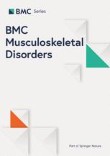
Abstract
Background
Work-related musculoskeletal disorders (WRMSDs) are a major constraint to worker performance and health. However, research on their prevalence and associated factors among workers at gold mines in the Democratic Republic of Congo (DRC) is insufficient. The present study aimed to determine the prevalence and predictors of WRMSDs among workers of a Gold Mine in South Kivu, DRC.
Methods
Cross sectional data on prevalence of WRMSDs and risk factors was collected using a modified Nordic questionnaire and upper limb Core QX checklist from 196 workers of a gold mine. WRMSDs were defined as pain or injury(ies) or discomfort, numbness or limitation of movement in the musculoskeletal system at any time in the past 12 months which lasted at least 24 h. These had to be either induced or aggravated by work and circumstances of its performance. A generalised linear model of the Poison family with link log and robust error variances was used to generate prevalence ratios (PRs) and 95% confidence intervals (CIs) for the factors associated with WRMSDs. The effect of individual, ergonomic and psychosocial factors on WRMSDs were investigated while controlling for known confounders.
Results
Most workers were males 187 (95.4%) and their age ranged between 23 and 60 years with mean of 36.3 years. Of the 196 workers, 49 (25.0%) reported having at least one WRMSD during the previous 12 months. WRMSDs with highest occurrence rate were the lower back pain (14.8%), followed by thighs/hip pain (9.2%) and shoulder pain (8.2%). Prolonged heavy lifting/shovelling shovelling (PR = 1.69, 95% CI [1.32, 3.24] and longer work shifts (> 9 h) (PR = 3.56, 95% CI [1.76, 16.58]) were predictive for WRMSDs while jobs with low demands were protective against WRMSDs (PR = 0.18, 95% CI [0.08, 0.44]).
Conclusion
The prevalence of WRMSDs is high and associated with prolonged heavy lifting/shovelling, longer work shifts and job demands. We recommend lowering workload and job demands and improving work ergonomics to mitigate and prevent the WRMSDs among workers in goldmines.



Δεν υπάρχουν σχόλια:
Δημοσίευση σχολίου